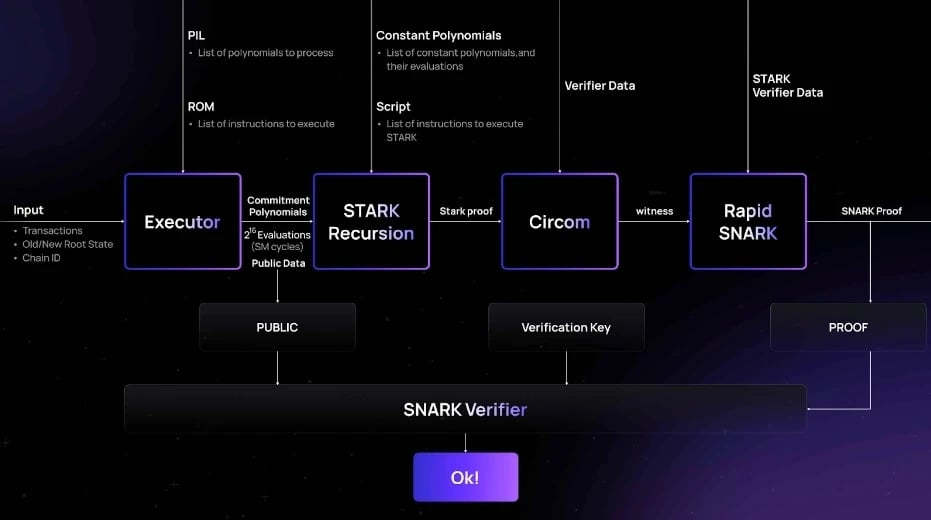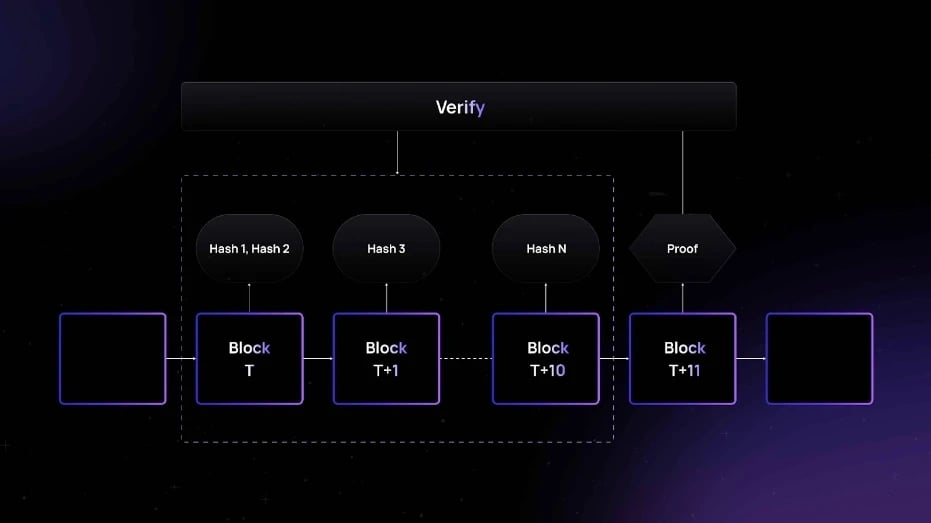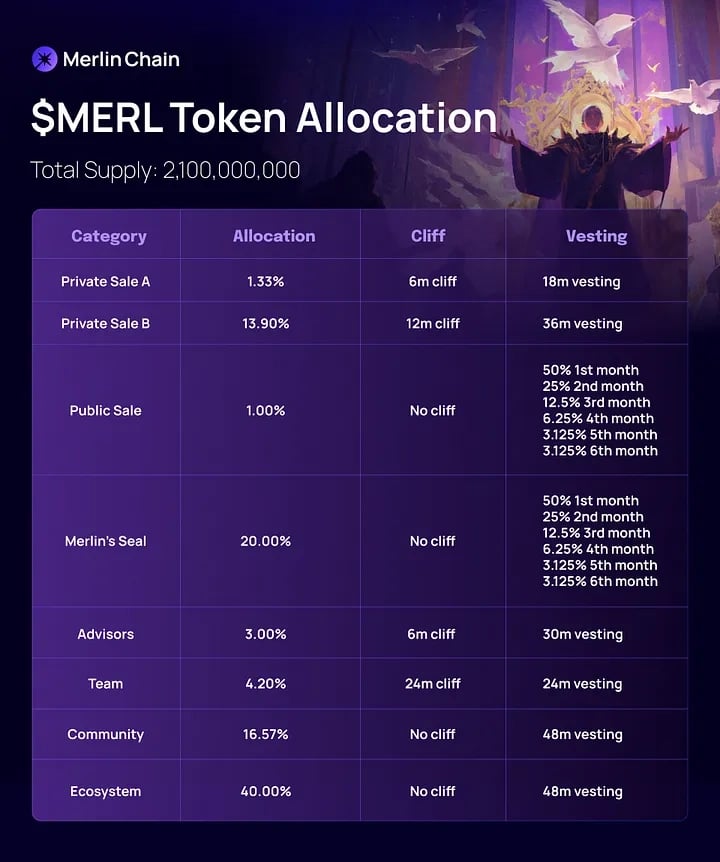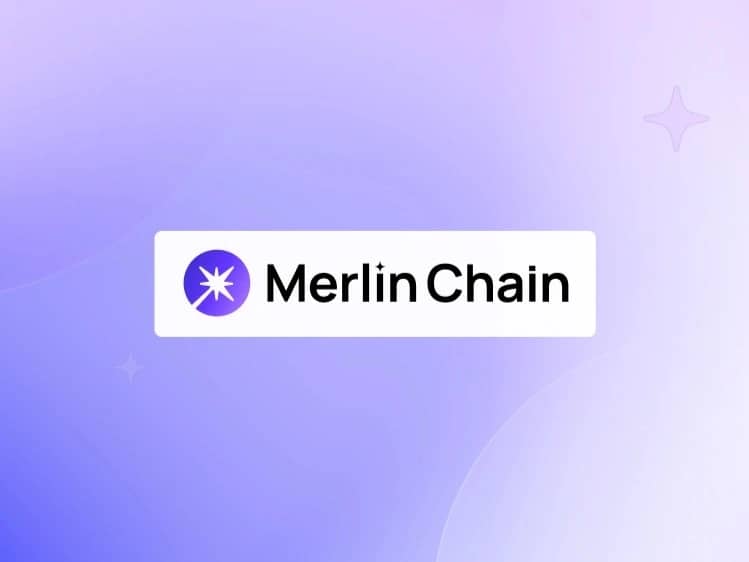Subscribe to wiki
Share wiki
Bookmark
Merlin Chain
Merlin Chain
Merlin Chain, founded by Jeff Yin and launched in 2024 by Bitmap Technology, is a Bitcoin Layer 2 solution designed to augment Bitcoin's native assets, protocols, and applications. Its primary aim is to enhance Bitcoin’s capabilities on Layer 1 through its Layer 2 infrastructure. [1] [12]

Overview
Merlin Chain focuses on enhancing scalability, efficiency, and functionality within the Bitcoin network. It incorporates key modules such as a ZK-Rollup Network for efficient transaction processing, a Decentralized Oracle Network for secure data transmission, and mechanisms for ensuring data availability and fraud detection based on Bitcoin's infrastructure.
The platform supports EVM compatibility and integrates seamlessly with Bitcoin-native wallets, enabling users to access major Bitcoin Layer 1 protocols like BRC-20 and Bitmap. By bridging Bitcoin with over 40 Ethereum chains, Merlin Chain simplifies adoption and fosters growth through cross-chain interactions. Its launchpad system further supports asset inscription and valuation, expanding opportunities for innovation within the Bitcoin ecosystem. [2] [3] [9]
Key Modules
ZK-Rollup Network
The ZK-Rollup Network in Merlin Chain enhances scalability and security by aggregating transaction data into batches, verified with zero-knowledge proofs and anchored to Bitcoin's mainnet via Taproot. It integrates nodes for data processing, a zkProver using SNARK technology for transaction validation, and a database for storing Merkle Tree and transaction details. This architecture inherits Bitcoin's security, supports EVM compatibility, reduces costs through optimized data usage, and ensures high performance with fast finality and scalability for large-scale user demands. [4]

Decentralized Oracle Network
Merlin Chain’s Decentralized Oracle Network securely processes and stores data by distributing tasks across sequencer nodes, which batch transactions, generate ZK state proofs, and upload data to Bitcoin's Taproot. Users can verify transactions through ZK proofs without exposing details, ensuring transparency and security. The system reduces centralization risks with fraud-proof mechanisms, multi-signature protocols, and cold storage. It supports staking multiple assets, automates staking and rewards through smart contracts, and offers real-time monitoring and a flexible withdrawal system for enhanced user control and liquidity. [5]
Data Availability
Merlin Chain collaborates with Celestia and Nubit to enhance data availability by ensuring transparent and verifiable block data publication. Its solution provides public access to network states, allowing anyone to view and store Merlin Chain’s data. Once confirmed on the data availability network, rollups and applications manage historical data storage. Nodes verify the availability of new blocks, ensuring data completeness and consistency across the network. [6]
Two-Step ZKP Submission Mechanism
Merlin Chain implements a Two-Step Zero-Knowledge Proof (ZKP) submission mechanism, inspired by Lumoz, to enable decentralized Proof of Work (PoW). In the first step, provers generate a ZKP for a sequence, calculate its hash, and submit it along with their address to a chain-level smart contract. This initial hash submission is open for T+10 blocks. After the T+11 block, provers can submit the complete ZKP, which validates previously submitted hashes. Verified provers are rewarded based on their stake proportion. This approach prevents race attacks, incentivizes continuous participation, and enhances system efficiency, security, and reliability. [7]

Fraud Detection
Merlin Chain employs a fraud-proof mechanism to ensure data integrity and security, utilizing two roles: Prover and Verifier. Provers pre-sign transactions and convert programs into binary circuits composed of NAND logic gates, with each gate's behavior represented by a leaf script. These scripts are organized into a Merkle Tree, with the Merkle Root submitted to a Taproot address. Verifiers retrieve the Merkle Root, validating its authenticity. If discrepancies are suspected, a challenge-response process is initiated, requiring the Prover to supply evidence supporting the root’s accuracy. This mechanism strengthens data correctness and mitigates fraudulent activity. [8]
Merlin Phantom
Merlin Phantom is an asset exchange protocol launched on Merlin Chain, enabling the seamless interchange of Bitcoin-based assets such as RUNES, BRC-20, BRC-420, and Ordinals NFTs. Developed collaboratively by UniCross and Merlin Chain, it aims to improve liquidity and broaden the use cases for BTC assets, providing users with expanded opportunities within the ecosystem. [10]
Tokenomics

Merlin Chain Token ($MERL)
The total supply of MERL is capped at 2,100,000,000 tokens, which will be gradually released over four years, beginning with the Token Generation Event (TGE). MERL runs on a BRC-20 standard and serves multiple functions within the Merlin Chain ecosystem, playing a key role in governance, security, and transaction efficiency. [11] [13]
Token Utility
- Governance: MERL holders can participate in the decision-making process by voting on proposals, ensuring community-driven governance.
- Staking: MERL can be staked to enhance network security, prevent Sybil attacks, and penalize malicious actors, contributing to the stability of the ecosystem.
- Transaction Fees: MERL is used for paying transaction fees within the Merlin Chain ecosystem, including Layer 3 networks, facilitating smooth economic activities.
- Delegating to Consensus Nodes: Token holders can delegate MERL to consensus nodes or stake it to operate one, supporting decentralization and scalability.
- Native Liquidity and Collateral: MERL can be used as liquidity and collateral, aiding transactions and supporting lending mechanisms to enhance the network's financial stability. [11]
Allocation

Merlin's Seal
Merlin's Seal is a staking event on Merlin Chain, where participants can earn M-points and claim $MERL, the governance token. 20% of the total $MERL supply is allocated as rewards. Users stake assets, and their value is converted to $BTC to calculate daily M-points, which determine their share of $MERL.
Rewards also include benefits for providing liquidity on Merlin Swap, participating in DeFi protocols, and staking ETH. Supported assets include BTC, BRC-20 tokens, Bitmap, BRC-420 tokens, ETH, USDT, and USDC. Users can stake via wallets like UniSat, OKX, and Bitget. Team leaders and members can earn bonus rewards based on total staked value. [14]
M-Token
M-Token is a representation of Layer 1 assets staked on the Merlin Chain during the "Merlin's Seal" event. When users stake assets such as Bitcoin or Ethereum on the Merlin Chain, they receive corresponding M-Tokens. Participants can mint M-Tokens with no gas fees and exchange them 1:1 for their original assets once they are unlocked. M-Tokens also facilitate interactions with NFT assets by including metadata like the Layer 1 NFT number and inscription ID.
Users can claim their original assets by destroying the corresponding M-Tokens during the unlocking process, which began in April 2024. [15] [16]
See something wrong?
